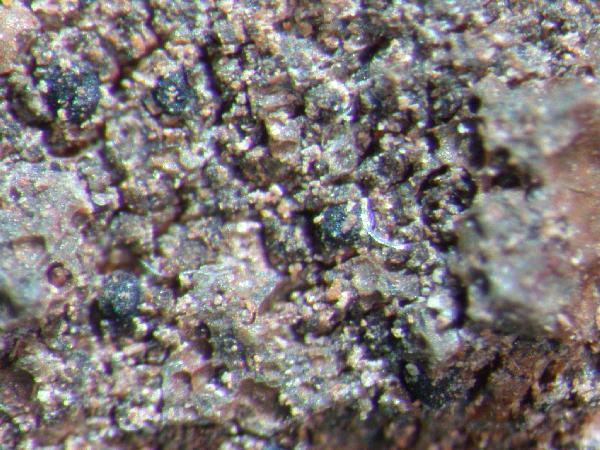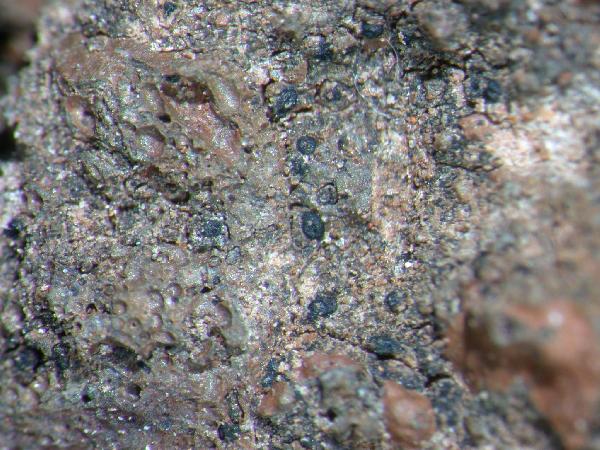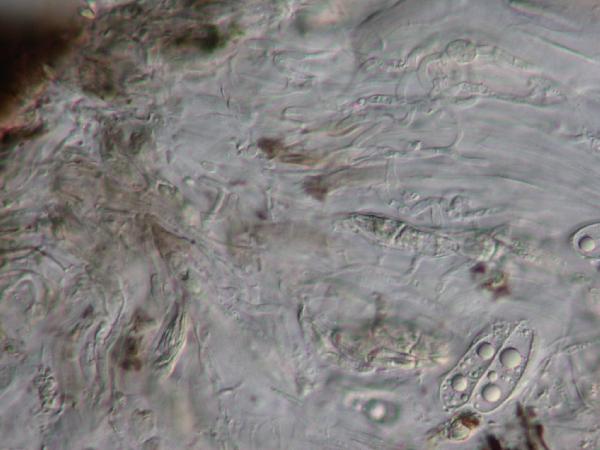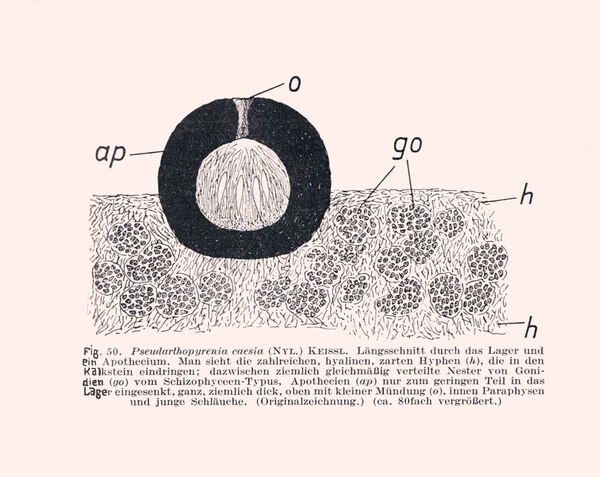Collemopsidium caesium (Nyl.) Coppins & Aptroot
Lichenologist, 40: 368, 2008. Basionym: Verrucaria caesia Nyl. - Bot. Not.: 162, 1853.
Synonyms: Arthopyrenia caesia (Nyl.) Zahlbr.; Arthopyrenia nylanderi (Hepp) Riedl; Leiophloea caesia (Nyl.) Trevis.; Leiophloea nylanderi (Hepp) Trevis.; Pseudarthopyrenia caesia (Nyl.) Keissl.; Pyrenocollema caesium (Nyl.) R.C. Harris; Sagedia nylanderi Hepp
Description: Thallus crustose, mostly endosubstratic and hardly distinguishable, but sometimes thinly episubstratic and appearing as dark brown to reddish brown or grey flecks. Perithecia scattered, black, subconical to globose, projecting to half-immersed, often depressed near the ostiole, 0.15-0.3(-0.5) mm in diam. Involucrellum absent; exciple dark throughout, more or less cellular; hamathecium of richly branched and anastomosed pseudoparaphyses, the hymenial gel I-. Asci 8-spored, ovoid to subcylindrical, usually stalked, with two functional wall layers, K/I-, the wall thickened above, with an ocular chamber, fissitunicate, with a distinct extruded rostrum at dehiscence. Ascospores 1-septate but sometimes with additional pseudosepta, hyaline, ovoid to ovoid-fusiform, both cells of similar shape and size, 20-30(-33) x (7.5-)8.5-12 µm. Pycnidia black, immersed, the conidiogenous cells cylindrical, phialidic. Photobiont cyanobacterial, the cells usually abundant, orange or blue-green, up to 12 µm wide. Spot tests: all negative. Chemistry: without lichen substances.
Growth form: Crustose endolithic
Substrata: rocks
Photobiont: cyanobacteria, filamentous (e.g. Nostoc, Scytonema)
Reproductive strategy: mainly sexual
Commonnes-rarity: (info)
Alpine belt: absent
Subalpine belt: very rare
Montane belt: very rare
Dry submediterranean belt: absent
Humid submediterranean belt: absent
Padanian area: absent
pH of the substrata:
1 2 3 4 5
Solar irradiation:
1 2 3 4 5
Aridity:
1 2 3 4 5
Eutrophication:
1 2 3 4 5
Poleotolerance:
0 1 2 3
Altitudinal distribution:
1 2 3 4 5 6
Rarity
absent
extremely rare
very rare
rare
rather rare
rather common
common
very common
extremely common
Loading data...
Occurrence data
Predictive map

Harrie Sipman - Source: https://archive.bgbm.org/digitalimages/Portosanto/Collemopsidium%20caesium%2074850%20DSCN6936.jpg
Aptroot 74850)

Harrie Sipman - Source: https://archive.bgbm.org/digitalimages/Portosanto/Collemopsidium%20caesium%2074850%20DSCN6936.jpg
Aptroot 74850)
Growth form: Crustose endolithic
Substrata: rocks
Photobiont: cyanobacteria, filamentous (e.g. Nostoc, Scytonema)
Reproductive strategy: mainly sexual
Commonnes-rarity: (info)
Alpine belt: absent
Subalpine belt: very rare
Montane belt: very rare
Dry submediterranean belt: absent
Humid submediterranean belt: absent
Padanian area: absent
pH of the substrata:
| 1 | 2 | 3 | 4 | 5 |
Solar irradiation:
| 1 | 2 | 3 | 4 | 5 |
Aridity:
| 1 | 2 | 3 | 4 | 5 |
Eutrophication:
| 1 | 2 | 3 | 4 | 5 |
Poleotolerance:
| 0 | 1 | 2 | 3 |
Altitudinal distribution:
| 1 | 2 | 3 | 4 | 5 | 6 |
Rarity
absent
extremely rare
very rare
rare
rather rare
rather common
common
very common
extremely common
Loading data...
Occurrence data
Predictive map

Harrie Sipman - Source: https://archive.bgbm.org/digitalimages/Portosanto/Collemopsidium%20caesium%2074850%20DSCN6936.jpg
Aptroot 74850)









